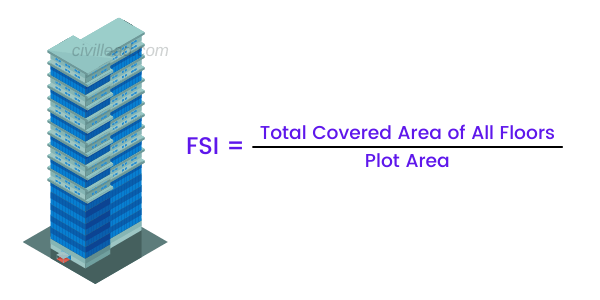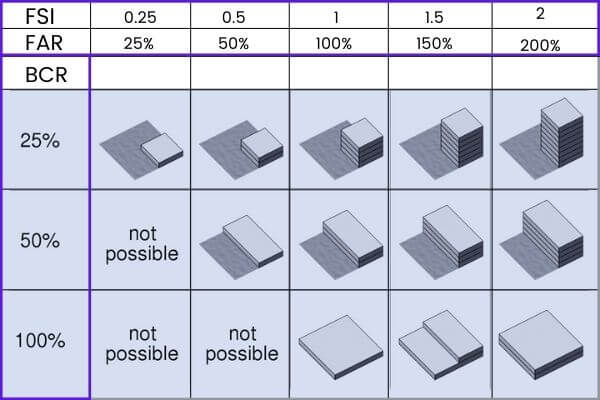Table of Contents
FSI Full Form
FSI refers to the floor space index. It is the ratio of the building’s area covered by all floors to the plot area available.
In simple words, it is the maximum area that can be allotted to construct on a plot and the maximum height up to which construction can be taken out on a plot.
It varies from city to city following the rules and regulations fixed by the municipal or local authorities.
The various points that are viewed in defining the value of FSI for a site are as follows.
- Type of Occupancy ( Residential or Non-residential)
- Type of Construction
- Front street Width of the proposed building and traffic load.
- The locality and density of the area where the building is proposed.
- Parking amenities
- Drainage, water supply, and fire fighting abilities.
FSI Importance
FAR helps to decide the developer’s construction limit on a plot of land. FSI controls the building’s vertical growth and living situations in metro cities.
Suppose if a local administration allows a higher FSI, resulting in more dense construction.
Lesser FSI means less dense construction. Thus it helps to control population residence density in an area.
Local authorities decide FSI for every region, considering the town’s future shape, water supply, sewerage system, solid waste disposal, and other essential factors. FSI may vary within a city.
Due to the scarcity of land, developers tend to build more. Although irregular or unplanned construction is not suitable for anyone as well as the town. Therefore FSI is mandated in all cities across India to regulate construction.
How To Calculate FSI?

National Building Code NBC has put up the specific value of FAR for various occupancies and types of construction.
The regional administration comes at the values of FAR for the area under its jurisdiction by using the primary FAR value as specified in NBC and changing the same depending on local factors.
Hence, if the area of a plot is 500 Sqm and the FAR specified by the local administration for the site is 1.5, then the maximum area of the building that can be constructed on that plot will be =1.5 × 500 = 750 Sqm.
Based on the road width in front of the plot, one can construct four-storeyed buildings, with each floor area of 187.5 Sqm, or a three-storeyed building with each floor area of 250 Sqm.
Plot Coverage
Apart from FSI/FAR, the local administration also defines the maximum allowable ground coverage for various types of possession, residential and commercial, which must be respected by the architect involving the design of the building and determining upon the building height or the number of stories.
Formula to Calculate FSI
The FSI value differs from one area to another, obtained from local authority or Development Control Regulations (DCR).
With the value of FSI, we can determine the allowable built-up area and number of building floors.
Allowable Built-Up Area = Plot Area X FSI
Allowed number of Floors = (Total Built-Up Area)/ (Maximum Plot Coverage)
The coverage area of the plot can be minimized from its maximum permissible limit if it is required to raise the number of Floors.
Also, Read – What is Carpet Area, Built-up Area and Super Built-up Area?
Example
Total Plot Area – 35,000 Sq.M
Maximum FSI – 5
Total Built-Up Area – 35000 X 5 = 175,000 Sq.M
Maximum Plot Coverage – 40%
40% of 35,000 = 14000 Sqm
So,
Maximum Plot Coverage in Ground Floor – 14000 Sqm
Maximum Numbers of Floors = Total Built-Up Area/Maximum Plot Coverage
175,000/14000 = 12.5
Maximum No of Floors = 12 Floors.
What is Premium FSI?
If FSI is restricted in your town and you want to extend the FSI limit, one option is Premium FSI. It is a charge paid to the authority for providing flexibility in permissible FSI.
Hence, If you want to increase your project’s permissible floor space index (FSI) limit, you have to pay a fee to the government as a Premium FSI fee.
But to get this benefit, the road along your land should have a minimum width of 30 feet.
- 30 – 40 Feet Wide Road – 20 % Premium FSI
- 40 – 60 Feet Wide Road – 30 % Premium FSI
- Greater than 60 Feet Wide Road – 40 % Premium FSI
If your land is located along a 30 to 40 feet wide road, you can get the benefit of premium FSI, which means you can build 20% extra than the permissible FSI.
What is FAR? Difference Between FAR and FSI

FAR refers to the Floor area Ratio, also called floor space index (FSI), which is the ratio of the total covered area (all floors) to the plot area.
Both terms FAR and FSI are used interchangeably. The difference between these two is that FAR is stated as a decimal number while FSI is an Index and is denoted in percentage.
The local authority of a particular area decides the FSI limit for a specific range to monitor building construction in that area.
The idea of FAR and FSI originated in America. And it was proposed to monitor building construction and help architects to design buildings as per the specified ratios.
But in India, the term FAR is mainly preferred, while in other countries, the term FSI is used.
Advantages of FSI or FAR
- FSI helps control the open area to built area ratio.
- FSI direct the city skyline.
- An average FSI value assures a sound development.
- With FSI, we can maintain a move toward balanced, sustained, and planned growth.
Disadvantages FSI or FAR
Usually, it is considered that FSI is a poor indicator of physical form. Lesser value of FSI influences accommodation and employment possibilities for the population. With the average value of FSI, it may be converted into an asset and shape the end product to resolve all the issues.
I hope now you have significant knowledge about FSI or FAR. If you consider this post informative, please share it.
Thanks!
Also, Read
What Does BHK Mean? BHK Full Form
Standard Room Sizes & Their Location In Residential Building
House Construction Cost Calculator Excel Sheet
What is Pointing? – Types of Pointing, Purpose, Method
10 Best Cement Companies In India 2021
10 Best Tiles Companies In India 2021